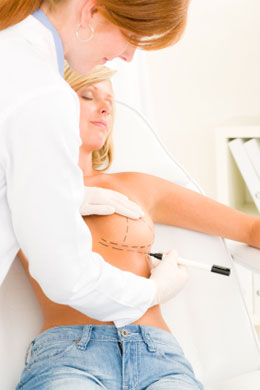Because breast implant surgery is more often carried out under general anaesthetic it has the same risks as other invasive surgical procedures, and in fact any kind of surgical procedure carries a small risk of infection. If the infection cannot be successfully treated with antibiotics the implant will probably be removed and replaced. The risk of infection is higher if a large haematoma (collection of blood) or seroma (collection of watery fluid) is present immediately after surgery. The body is able to absorb small haematomas or seromas but may need the help of a surgical drain to remove larger ones. Surgical draining can also increase the risk of deflation or rupturing.
It takes a few months for the breasts to settle after breast implant surgery and in the short term patients might experience some swelling, hardness and discomfort with some bruising, twinges and pains possibly over the first few weeks. If patients suffer excessive swelling, deflated breasts, offensive wound discharge or excessive pain or heat in their breast they should report these symptoms immediately to their surgeon or GP.
Most common risks
The most common risk with breast implants is Capsular Contracture, though this is low with modern implants which have a micropolyurethane coating . Capsular contracture is estimated to occur in around one in 10 women after breast implant surgery and requires further surgery to remove and replace the implant. It occurs when the scar tissue that naturally forms around the breast implant begins to shrink causing the implant to harden and sometimes deform.
Rupturing occurs when the breast implants split or tear but this does not necessarily create a medical problem as different fillers will react differently, and this was more common with early, thin-walled implants. The obvious risk from ruptured implants is that the contents of the implant will escape from the shell into the breast and cause siliconomas (small lumps) which in turn cause tenderness or pain in the breast. If this happens the implant needs to be taken out, but the firm silicon breast implants are less likely to cause these complications as they are designed to keep their shape even if the implant shell ruptures. In the majority of cases the silicone gel will remain within the capsule that the body forms and can be removed if the ruptured implant is removed.
Deflation- means that the implant has deflated and reduced in size and can occur as a result of complications after surgery such as capsular contracture and rupturing. Occasionally, implant surgery can cause small amounts of calcium to form around the implant, which may be confused as tumours on a mammography.
The silicone controversy – the silicon implant has been the subject of much controversy after women claimed to have Connective Tissue Disorders (CTDs) and other illnesses from the silicone gel which related mainly to silicone gel leakage and possible migration to other parts of the body. Reported symptoms included muscle spasm and pain, swollen and painful joints, rashes, changed eye and saliva fluid and hair loss. However, studies show that the incidence of CTDs is no higher in women with silicon implants than with women without implants and the Independent Review Group’s (IRG) report in 1998 found no scientific relationship between silicone gel implants and immune reactions, no relationship between silicone gel implants and long-term systemic illness (affecting the whole body), nor with specific connective tissue disease or non-specific systemic illness.
Breast Cancer -evidence suggests that women who have breast implants have no increased risk of developing breast cancer – in fact it is thought that the risk may actually be less. However, if a woman who has breast implants develops breast cancer scientific studies have consistently shown that the risk of cancer recurring is no greater than in women without implants, and that there is no difference in their survival.
In a small number of women scars will be red or highly coloured, thick, painful and will take several years to improve. Other risks associated with breast implants include blood loss, creasing or rippling of the breast around the implant and a loss of sensation in the breast. One in 10 women who have had breast implants experience fibrous capsules contracting which causes the implant to deform, become hard or painful. In these cases then the implant and the capsule should be removed and if required replaced with another implant.
An implant placement between the breast and the chest muscle is called a sub glandular placement and a breast implant placed behind the chest muscle is called a sub muscular placement. With sub glandular placement the surgery and recovery time is shorter and less painful, but there is more risk of the implant hardening and deforming (capsular contracture) and it can cause difficulties with mammography imaging. The sub muscular placement tends to be more uncomfortable and the recovery time longer but achieves a more natural breast appearance and decreases the risk of problems with mammography.
There are three main types of incisions commonly used to insert breast implants, and these should be discussed with the surgeon beforehand:
1) The Periareolar incision is made around the nipple and leaves minimal scarring but potentially causes breastfeeding difficulties.
2) An Inframammory incision is the most popular incision because it doesn’t cause problems with breastfeeding or leave bad scars. Small cuts are made underneath each breast to insert the breast implant.
3) The Axillary incision is made in the armpit area around the side of the breast and will leave more of a visible scar than the other incisions, but doesn’t cause difficulties with breastfeeding.
The operation is carried out either under general or local anaesthetic (sometimes as day surgery, but usually with an overnight stay in hospital) and the procedure takes around an hour. An incision (surgical cut) is made in or near the breast and the surgeon will create a pocket for the breast implant to lie in, either beneath the muscle or beneath the breast tissue (size and shape will determine the outcome of the position of the implant and the patient should discuss this with their surgeon).
Following surgery dissolvable stitches will need to be removed and a sports bra worn 24 hours a day for up to three months. The breasts will be firm and swollen at first and will take several weeks to settle into a natural position but the sports bra can help the patient to feel more comfortable.



